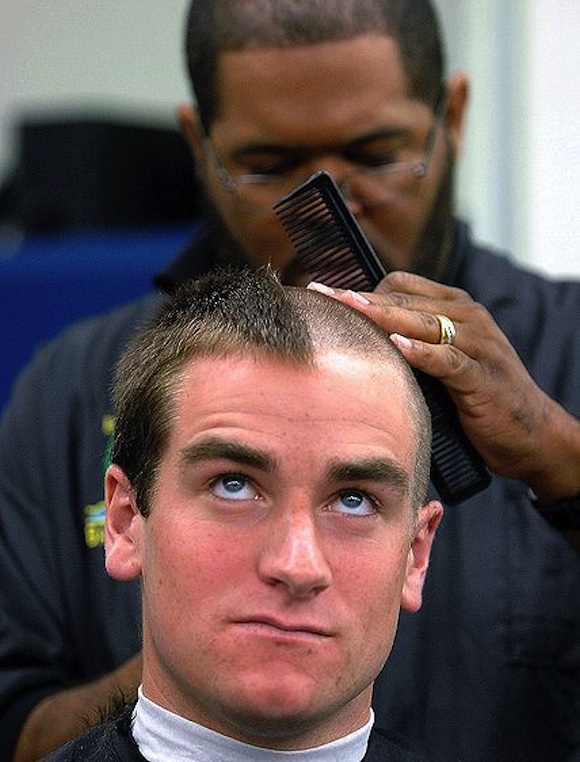
Beauty in Japan is serious business. This might be the explanation for why “beauty salon” in Japanese shares a kanji character with both “graduate school” and “hospital.”* The treatment you’re liable to get at a Japanese beauty salon often far outpaces that of Western salons; typically you can expect a thorough scalp massage and drink service at the very least, and shoulder and hand massages and in-depth style counseling are not uncommon either.
And that’s just scratching the surface. Here is a list of differences between Japanese and Western hair salons:
The expert shampoo service
Getting a thorough shampooing – and yes, spell check assures us that is a word – is pretty common across the board, but what sets Japanese hair salons apart is the ample attention paid to your scalp during your visit. Sure, that sounds weird, but you’ll be too appreciative to be embarrassed as your Japanese stylist spends many minutes massaging your scalp and identifying problem areas. Usually, your stylist will ask you if any areas are especially itchy or sensitive and investigate for you, all while expertly massaging and scrubbing, sending tingles down your spine the likes of which you only thought possible in the bedroom.
The Coupons
Since, as we’ve established, beauty is serious business in Japan, it goes without saying that it’s also a cutthroat business. For you, the consumer, this is nothing but a good thing; anywhere you go in Tokyo you’ll see smiling 20-somethings handing out fliers and tissues, often associated with hair and beauty salons. Look closely and you’ll see that many of the fliers contain special offers, from heavy discounts for first-time visitors to completely free service if that person on the street happens to think you’d make a good hair model.
Drink Service
At pretty much any decent Japanese hair salon you go to, drink service is part of the deal. Sure, you’re paying more for the privilege of getting your hair cut than at Western establishments, but in exchange you can enjoy a wide variety of drinks. Most of the time, this is limited to a few tea options and coffee, but really fancy places have been known to offer champagne and other classy beverages free of charge.
The “Cape”
Most western salons have a selection of protective drapes that they wrap around you and clasp at the throat. Your hands are pretty much stuck underneath the drape and if you want to, say, respond to a cell phone message, you have to awkwardly stick your hands out of the sides of the drape, all the while exposing your legs and hips to a relentless onslaught of hair clumps falling from your head. In Japan, they offer a type of cape with convenient arm holes that let you freely gesticulate and answer cell phone messages to your heart’s content without ever exposing your clothing to that hard-to-get-rid-of freshly cut hair.
The Crazily Specific Questions
“How many centimeters do you want it?”
“Are you planning on using hair wax every day or just sometimes?”
“Do you want to be able to put the front of your hair down when you feel like it, or do you want it up all the time?”
Not all of the differences are for the better. In an effort to give the most personalized service they can, Japanese stylists will ask a range of bizarre and super specific questions that might grate on you and make you want to scream, “I have no idea! You’re the expert!”
Your humble writer, as a man, usually walks into a styling joint with a simple request: “Make it shorter.” So it can be baffling and annoying when your stylist seems to be second guessing his/her every styling decision, asking increasingly specific questions about how you want your hair to look when you really just want them to make it look cool. A lot of guys walk into a salon looking like they just rolled out of a dumpster and want the stylist to make months of growth and on-and-off washing look like you actually give a damn about what you look like. We don’t care how many centimeters it ends up being, okay?
So, have you ever been to a Japanese beauty salon before? What are the differences in your mind? What are the pros and cons of Japanese salons? Let us know in the comments.
*“Beauty salon” (biyouin, 美容院), shares its final character with “graduate school” (daigakuin, 大学院) and “hospital” (byouin, 病院).
Photo: Wikimedia Commons

 Live your billionaire dreams with a shampoo from a team of beautiful models at this Tokyo event
Live your billionaire dreams with a shampoo from a team of beautiful models at this Tokyo event Does getting a perm help hide the thinning hair spots on your head? We try it and find out
Does getting a perm help hide the thinning hair spots on your head? We try it and find out Hair salon just for otaku would turn getting a haircut into a mini anime convention experience
Hair salon just for otaku would turn getting a haircut into a mini anime convention experience Let’s go get a haircut at Tokyo’s anime otaku hair salon【Photos】
Let’s go get a haircut at Tokyo’s anime otaku hair salon【Photos】 Exchange student goes to Japanese salon for the first time, comes out totally transformed!【Video】
Exchange student goes to Japanese salon for the first time, comes out totally transformed!【Video】 We revisited Sweets Paradise after a decade to see if Japan’s dessert buffet still delivers
We revisited Sweets Paradise after a decade to see if Japan’s dessert buffet still delivers Starbucks Japan ready to get Year of the Horse started with adorable drinkware and plushies【Pics】
Starbucks Japan ready to get Year of the Horse started with adorable drinkware and plushies【Pics】 Hayao Miyazaki says Happy New Year to Studio Ghibli fans with new art for Year of the Horse
Hayao Miyazaki says Happy New Year to Studio Ghibli fans with new art for Year of the Horse Survey finds more than 70 percent of Japanese children have an online friend
Survey finds more than 70 percent of Japanese children have an online friend Randy’s Donuts opens first-ever branch in Japan, brings L.A.’s donuts to Tokyo【Photos】
Randy’s Donuts opens first-ever branch in Japan, brings L.A.’s donuts to Tokyo【Photos】 Super long ebi fry proves Japanese portion sizes aren’t always small
Super long ebi fry proves Japanese portion sizes aren’t always small Biryani Restaurant in the Middle of Tokyo Offers a Delightful Taste of Spice with Your Rice, Open One Day a Week
Biryani Restaurant in the Middle of Tokyo Offers a Delightful Taste of Spice with Your Rice, Open One Day a Week Is the all-you-can-eat KFC buffet in Tokyo really as good as they say it is?
Is the all-you-can-eat KFC buffet in Tokyo really as good as they say it is? Typhoon destroys real Ghost of Tsushima island shrine torii gate, crowdfunding campaign launched
Typhoon destroys real Ghost of Tsushima island shrine torii gate, crowdfunding campaign launched Harajuku’s new permanent Tamagotchi shop is filled with cuteness and a surprising lack of poop
Harajuku’s new permanent Tamagotchi shop is filled with cuteness and a surprising lack of poop 7-Eleven Japan’s ramen-cooking robot whipped us up a bowl of noodles【Taste test】
7-Eleven Japan’s ramen-cooking robot whipped us up a bowl of noodles【Taste test】 Cyberpunk anime meets traditional culture in Ghost in the Shell gold leaf Japanese changing screens
Cyberpunk anime meets traditional culture in Ghost in the Shell gold leaf Japanese changing screens 7 great places to see Mt. Fuji from without having to climb it
7 great places to see Mt. Fuji from without having to climb it Hello Kitty Choco Egg figures are an adorable trip through three periods of Japanese pop culture【Pics】
Hello Kitty Choco Egg figures are an adorable trip through three periods of Japanese pop culture【Pics】 Japan’s otoshidama tradition of giving kids money at New Year’s gets a social welfare upgrade
Japan’s otoshidama tradition of giving kids money at New Year’s gets a social welfare upgrade We found possibly the quietest Japanese-style hotel in Tokyo’s bustling Shinjuku district
We found possibly the quietest Japanese-style hotel in Tokyo’s bustling Shinjuku district Lacquerware supplier to emperor of Japan and Pokémon team up for new tableware
Lacquerware supplier to emperor of Japan and Pokémon team up for new tableware Sumo Sanrio! Hello Kitty and pals team up with Japan Sumo Association for new merch【Pics】
Sumo Sanrio! Hello Kitty and pals team up with Japan Sumo Association for new merch【Pics】 Can a dirty butthole make you filthy rich in Japan? We’re starting a New Year’s lottery experiment
Can a dirty butthole make you filthy rich in Japan? We’re starting a New Year’s lottery experiment 7-Eleven Japan starts new temporary luggage storage service in over 300 branches
7-Eleven Japan starts new temporary luggage storage service in over 300 branches Disillusionment at Tsukiji’s tourist-target prices led us to a great ramen restaurant in Tokyo
Disillusionment at Tsukiji’s tourist-target prices led us to a great ramen restaurant in Tokyo Starbucks teams up with 166-year-old Kyoto doll maker for Year of the Horse decorations【Photos】
Starbucks teams up with 166-year-old Kyoto doll maker for Year of the Horse decorations【Photos】 Tokyo considering law requiring more trash cans following litter increase in heavily touristed area
Tokyo considering law requiring more trash cans following litter increase in heavily touristed area Tokyo’s Tsukiji sushi neighborhood asks tour groups to stay away for the rest of the month
Tokyo’s Tsukiji sushi neighborhood asks tour groups to stay away for the rest of the month Nintendo’s Kirby now delivering orders at Kura Sushi restaurants, but not in Japan
Nintendo’s Kirby now delivering orders at Kura Sushi restaurants, but not in Japan Tokyo event lets you travel back in time, for free, to celebrate 100 years since Showa era start
Tokyo event lets you travel back in time, for free, to celebrate 100 years since Showa era start Sanrio theme park in Japan announces plans to expand into a Sanrio resort
Sanrio theme park in Japan announces plans to expand into a Sanrio resort Japan may add Japanese language proficiency, lifestyle classes to permanent foreign resident requirements
Japan may add Japanese language proficiency, lifestyle classes to permanent foreign resident requirements Survey asks foreign tourists what bothered them in Japan, more than half gave same answer
Survey asks foreign tourists what bothered them in Japan, more than half gave same answer Japan’s human washing machines will go on sale to general public, demos to be held in Tokyo
Japan’s human washing machines will go on sale to general public, demos to be held in Tokyo Japan’s deadliest food claims more victims, but why do people keep eating it for New Year’s?
Japan’s deadliest food claims more victims, but why do people keep eating it for New Year’s? We deeply regret going into this tunnel on our walk in the mountains of Japan
We deeply regret going into this tunnel on our walk in the mountains of Japan Studio Ghibli releases Kodama forest spirits from Princess Mononoke to light up your home
Studio Ghibli releases Kodama forest spirits from Princess Mononoke to light up your home Major Japanese hotel chain says reservations via overseas booking sites may not be valid
Major Japanese hotel chain says reservations via overseas booking sites may not be valid Put sesame oil in your coffee? Japanese maker says it’s the best way to start your day【Taste test】
Put sesame oil in your coffee? Japanese maker says it’s the best way to start your day【Taste test】 No more using real katana for tourism activities, Japan’s National Police Agency says
No more using real katana for tourism activities, Japan’s National Police Agency says Starbucks Japan reveals new sakura drinkware collection, inspired by evening cherry blossoms
Starbucks Japan reveals new sakura drinkware collection, inspired by evening cherry blossoms Updated cherry blossom forecast shows extra-long sakura season for Japan this year
Updated cherry blossom forecast shows extra-long sakura season for Japan this year One of Tokyo’s best hair salons discovered: this dank parking garage!
One of Tokyo’s best hair salons discovered: this dank parking garage! Getting a haircut in Japan: A survival guide
Getting a haircut in Japan: A survival guide Tokyo’s by-anime-fans, for-anime-fans hair salon is now open for business
Tokyo’s by-anime-fans, for-anime-fans hair salon is now open for business What it’s like to get a haircut at Japan’s oldest barber shop
What it’s like to get a haircut at Japan’s oldest barber shop You can now get stick-on salon masks for haircuts in the coronavirus age in Japan
You can now get stick-on salon masks for haircuts in the coronavirus age in Japan Can a Tokyo hair salon change Mr. Sato into Joe Biden?
Can a Tokyo hair salon change Mr. Sato into Joe Biden? Mr. Sato gets his bush trimmed at a fancy Tokyo hair salon【Photos】
Mr. Sato gets his bush trimmed at a fancy Tokyo hair salon【Photos】 We get a haircut by a stylist who cuts with katanas and fire at “Samurai Salon” in Spain
We get a haircut by a stylist who cuts with katanas and fire at “Samurai Salon” in Spain Catalogue featuring only “ugly” hair models helps us feel less awkward at the salon
Catalogue featuring only “ugly” hair models helps us feel less awkward at the salon Japanese government recognizes equal salon rights, men now “permitted” to get haircuts in them
Japanese government recognizes equal salon rights, men now “permitted” to get haircuts in them Can a Tokyo hair salon change you into today’s hottest anime character from Demon Slayer?【Photos】
Can a Tokyo hair salon change you into today’s hottest anime character from Demon Slayer?【Photos】 Nepalese-run Tokyo hair salon gave us the number-one hairstyle for handsome Nepalese men【Pics】
Nepalese-run Tokyo hair salon gave us the number-one hairstyle for handsome Nepalese men【Pics】 Tokyo hair salon offers free cuts to anime fans whose 2-D crush fell in love with someone else
Tokyo hair salon offers free cuts to anime fans whose 2-D crush fell in love with someone else We Take Mr. Sato for a Shampoo and Trim at the Pet Salon 【Thrifty Style】
We Take Mr. Sato for a Shampoo and Trim at the Pet Salon 【Thrifty Style】 New Head Spa Massage Unit Promises Extreme Relaxation, Makes You Look Like Robocop
New Head Spa Massage Unit Promises Extreme Relaxation, Makes You Look Like Robocop Black telephone like me: What if a handsome guy tries modern politics’ most famous harido?
Black telephone like me: What if a handsome guy tries modern politics’ most famous harido?
Leave a Reply